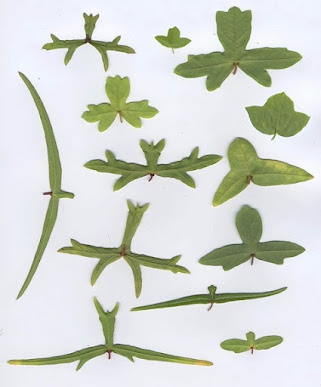 |
| Birdwing Passionvine |
While many flower and butterfly gardeners are familiar with the more common Passiflora species, namely Purple (P. incarnata), Yellow (P. lutea), and Stinking Passionvines (P. foetida), they are not the only species in this genus native to Texas. Some of the unfamiliar native species include Bracted Passionvine (P. affinis), Corkystem Passionvine (previously P. suberosa now P. pallida), and Birdwing or Slender-lobe Passionvine (P. tenuiloba).
The Bracted Passionflower is a climbing vine to 15 feet in length, with alternate, three-lobed leaves that is found growing in riparian to dry limestone areas of the Edwards Plateau. The leaves are often appropriately shaped somewhat like cowboy hats. While similar to Yellow Passionvine, it is distinguished by having tiny nectaries on the underside of the leaves and small bracts or leaflike structures at the base of each flower. Each of these intricate flowers are pale yellowish-green to white and about 1 inch across with yellow fringelike segments purple at the base, and they can appear from May through October. They produce small round berries 0.4 inches across that are green at first, but turn purple-black as they ripen.
 |
| Bracted Passionvine |
 |
Tiny dots on the surface of Bracted Passionflower leaves indicate the nectaries below, differentiating it from Yellow Passionvine |
With stems up to 20 feet long, Corkystem Passionvine is naturally found in a few counties in South Texas, preferring subtropical woodlands and shrublands with rocky, sandy, and often calcareous soil. Its common name comes from the corky bark it develops at the base of older stems. Alternate, three-lobed leaves are 1 to 4 inches long, somewhat glossy, and dark green. Its 1-inch, complex blooms can be white, yellow, or green with a tinge of reddish-purple at the base of the yellow fringelike segments. Blooming can occur any month of the year, eventually yielding bluish-black, slightly egg-shaped berries up to about 0.25 inches in diameter.
 |
| Corkystem Passionvine |
The hardest-to-find small Passiflora vine is the Birdwing or Slender-lobe Passionflower (Passiflora tenuiloba). Growing on open limestone areas with dry, caliche soils, often over boulders or tree stumps mainly in the Edwards Plateau to South and West Texas, this vine can display quite a wide variety of leaf forms (compare the leaf shape the photo below with the one in the banner at the top of the post, for example). While roughly symmetric, the alternate leaves are typically as wide as to usually wider than long, 3 to 9 lobed, and resemble the outline of a bird with spread wings. Its small, intricate blooms are 0.75 inches across, greenish-yellow with yellow fringelike segments that can be purple at the base. Flowers can appear from April to December, turning into 0.35 inch wide dark blue to black berries.
 |
| Birdwing Passionvine |
 |
| Birdwing Passionvine Leaf Variation ©Doug Goldman, 2001, Cornell University |
Most Passiflora species are host plants for longwing and fritillary (Heliconian) butterflies, such as the more common Gulf Fritillary and Variegated Fritillary, as well as the less common Zebra Heliconian and Julia Heliconian. The larvae of these species feed on passionvines, and chemicals from these plants make the adults noxious to predators.
The naming of the Passiflora genus of plants comes from the description of their intricate flower parts in the early 17thcentury by Spanish priests. Known by the Spanish as La Flor de las Cincos Llagas or ‘The Flower with Five Wounds’, the passion flower refers to Christ’s suffering and its parts represent various elements of the crucifixion. The five petals and five sepals are the ten disciples less Judas and Peter, the corona filaments are the crown of thorns, the five stamens with anthers are the five sacred wounds, and the three stigmas are the nails by which Christ was bound to the cross. While this symbolism is not universal, it is still an important reminder today in Christian societies throughout the world.